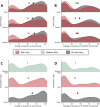Icon arrays reduce concern over COVID-19 vaccine side effects: a randomized control study
- PMID: 35524896
- PMCID: PMC9077983
- DOI: 10.1186/s41235-022-00387-5
Icon arrays reduce concern over COVID-19 vaccine side effects: a randomized control study
Abstract
On April 13, 2021, the CDC announced that the administration of Johnson and Johnson's COVID-19 vaccine would be paused due to a rare blood clotting side effect in ~ 0.0001% of people given the vaccine. Most people who are hesitant to get a COVID-19 vaccine list potential side effects as their main concern (PEW, 2021); thus, it is likely that this announcement increased vaccine hesitancy among the American public. Two days after the CDC's announcement, we administered a survey to a group of 2,046 Americans to assess their changes in attitudes toward COVID-19 vaccines. The aim of this study was to investigate whether viewing icon arrays of side effect risk would prevent increases in COVID-19 vaccine hesitancy due to the announcement. We found that using icon arrays to illustrate the small chance of experiencing the blood clotting side effect significantly prevented increases in aversion toward the Johnson and Johnson vaccine as well as all other COVID-19 vaccines.
© 2022. The Author(s).
Conflict of interest statement
Not applicable.
Figures



References
-
- Bürkner P-C. brms: An R package for Bayesian multilevel models using Stan. Journal of Statistical Software. 2017 doi: 10.18637/jss.v080.i01. - DOI
-
- Bürkner P-C. Advanced Bayesian multilevel modeling with the R Package brms. The R Journal. 2018;10(1):395. doi: 10.32614/RJ-2018-017. - DOI
-
- Centers for Disease Control and Prevention. (2021). J&J/Janssen Update. https://www.cdc.gov/coronavirus/2019-ncov/vaccines/safety/JJUpdate.html
Publication types
MeSH terms
Substances
LinkOut - more resources
Full Text Sources
Medical
Miscellaneous
